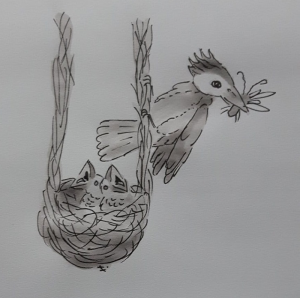Difference between revisions of "Basket Finch"
From World of Entorais Wiki
Jump to navigationJump to searchm (file) |
m (Text replacement - "Sub-Species" to "Notable Sub-Species") |
||
| (3 intermediate revisions by the same user not shown) | |||
| Line 1: | Line 1: | ||
[[File:Basket_finch.png|thumb|right|100x| | [[File:Basket_finch.png|thumb|right|100x|Basket Finch - "Sebastian Romu" © 2019]] | ||
==About== | ==About== | ||
;Common Names:Basket Finch | ;Common Names:Basket Finch | ||
;Classification:Bird | ;Classification:Bird | ||
: | :Small birds which weave hanging basket-like nests from grasses. A colony of such birds can produce enough nests to make a savanna tree appear to have an abundance of hanging fruit. | ||
==Description== | ==Description== | ||
;Size: <--number--> kg (<--number--> pounds), <--height--> m ( <--height--> feet/inches), <length--> as appropriate | ;Size: <--number--> kg (<--number--> pounds), <--height--> m ( <--height--> feet/inches), <length--> as appropriate | ||
;Appearance: <!--general description, include body part ratios as required, consider: skeleton, mobility, body covering, respiratory system, nervous System, additional features--> | ;Appearance: <!--general description, include body part ratios as required, consider: skeleton, mobility, body covering, respiratory system, nervous System, additional features--> | ||
;Sexual Dimorphism: | ;Sexual Dimorphism:Males of this species tend to have brighter plumage, and also sport a crest of feathers at the back of their head. | ||
;Variance: <!--any other variance, include subspeciation--> | ;Variance: <!--any other variance, include subspeciation--> | ||
==Ecology== | ==Ecology== | ||
;Habitat: | ;Habitat:Tropical to Subtropical, Savanna | ||
;Diet: | ;Diet:Omnivorous, these birds eat a variety of insects, fruits and seeds. | ||
==Behaviour== | ==Behaviour== | ||
;Social Grouping: | ;Social Grouping:Solitary or mated pairs. They do not form flocks, but do have nesting colonies occupying tall flat canopied trees, where their numbers and position provides a measure of mutual protection from predators. | ||
;Temperament: | ;Temperament:Wary. | ||
;Intelligence: | ;Intelligence:Animal | ||
;Reproduction: | ;Reproduction:A bonded pair of these birds will mate in the early Spring, and the female will lay 2-3 eggs in the pair's nest. Young hatch in 20-30 days and remain dependent on their parents for food another two months before being capable of flying on their own by Summer. | ||
<!-- Additional Behaviour notes --> | <!-- Additional Behaviour notes --> | ||
==Sub-Species== | ==Notable Sub-Species== | ||
:<!--list of sub-species with notable differences--> | :<!--list of sub-species with notable differences--> | ||
==Domestication== | ==Domestication== | ||
;General: | ;General:None. They are not considered a nuisance in most places, as they reduce the population of crop damaging insects pests. | ||
;Resources: | ;Resources:None | ||
==Stories== | ==Stories== | ||
| Line 33: | Line 33: | ||
:<!--List any stories relating to or about this fauna--> | :<!--List any stories relating to or about this fauna--> | ||
</div> | </div> | ||
==See Also== | ==See Also== | ||
:<!--links to related material--> | :<!--links to related material--> | ||
Latest revision as of 01:12, 20 April 2023
About
- Common Names
- Basket Finch
- Classification
- Bird
- Small birds which weave hanging basket-like nests from grasses. A colony of such birds can produce enough nests to make a savanna tree appear to have an abundance of hanging fruit.
Description
- Size
- <--number--> kg (<--number--> pounds), <--height--> m ( <--height--> feet/inches), <length--> as appropriate
- Appearance
- Sexual Dimorphism
- Males of this species tend to have brighter plumage, and also sport a crest of feathers at the back of their head.
- Variance
Ecology
- Habitat
- Tropical to Subtropical, Savanna
- Diet
- Omnivorous, these birds eat a variety of insects, fruits and seeds.
Behaviour
- Social Grouping
- Solitary or mated pairs. They do not form flocks, but do have nesting colonies occupying tall flat canopied trees, where their numbers and position provides a measure of mutual protection from predators.
- Temperament
- Wary.
- Intelligence
- Animal
- Reproduction
- A bonded pair of these birds will mate in the early Spring, and the female will lay 2-3 eggs in the pair's nest. Young hatch in 20-30 days and remain dependent on their parents for food another two months before being capable of flying on their own by Summer.
Notable Sub-Species
Domestication
- General
- None. They are not considered a nuisance in most places, as they reduce the population of crop damaging insects pests.
- Resources
- None
